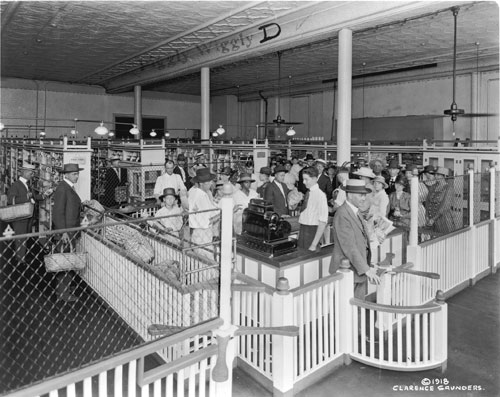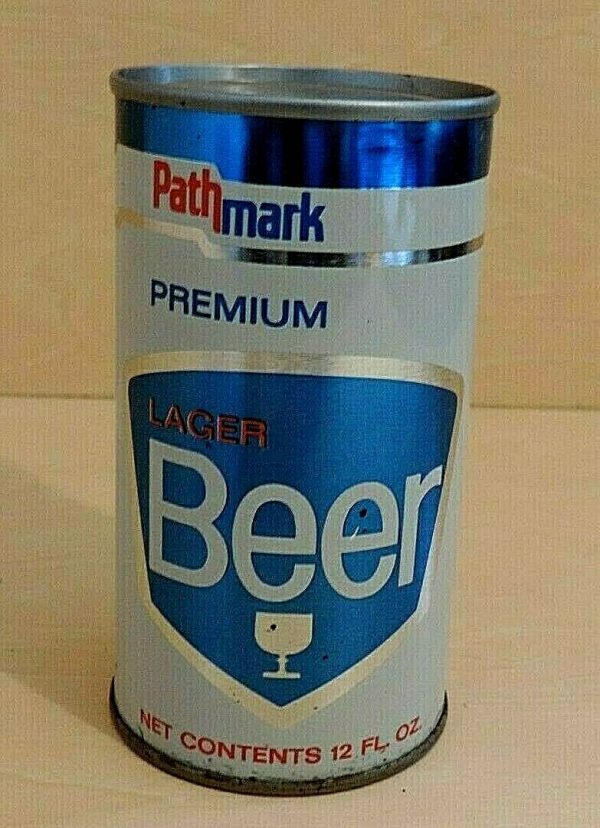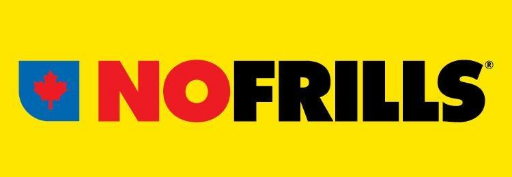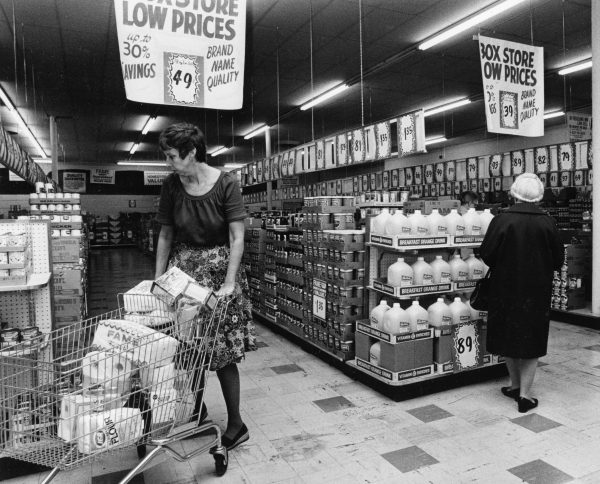About a hundred years ago, we didn’t really have supermarkets. If you went shopping, you had to go to a greengrocer, and then to the butcher, then someone delivered your milk, and it was so, so time-consuming. But in 1916, a man named Clarence Saunders opened a store in Tennessee called Piggly Wiggly, which was the first place with “self-service” groceries—rows of products you could pick out yourself. Soon, America was overrun with grocery stores.

In the early days, most grocery stores carried local products, but after World War II, they were filled with famous, national brands. A couple of factors helped the big brands take over, such as the new interstate highway system, which made it easy to deliver goods, and the rise of television. According to radio host and adman Terry O’Reilly, the national brands would reach up to 80% of the market by advertising on the three biggest television shows.
What’s in a Name?
The name brands became dominant and made up most of what people bought at grocery stores in North America. To fill out the store shelves, supermarkets would make their own store brand products too. Usually, these looked similar to the big brands, but with the name of the supermarket slapped on the side of the box.

Store brands were most popular with people who wanted a low budget alternative to the name brand stuff, says Stephen Hoch an emeritus marketing professor at the Wharton School of Business. Store brands only made up 13% of the inventory being sold in grocery stores by 1970. But they received a boost during the next decade.
Les Produits Libres
After the oil crisis, the global economy went into a recession. American unemployment hit 11 percent. And suddenly, middle-class families didn’t have money for name brands like Coke or Kellogg’s. Consumers wanted cheaper food. In response, supermarkets had to figure out how to make their store brands more appealing. One chain in France, called Carrefour, was developing a discount store brand when they had an idea. Instead of using bright colors, or putting their own name on the box, or using slogans or beautiful photos, their products were brandless. They would include just the name of the food, in black text, on a white background. This minimalist design was a brilliant marketing tool. It delivered the message that the food was cheap, and the savings were being passed down to consumers.
In 1976 Carrefour launched the new product line, which they called “Les Produits Libres,” which means in English “free products.” Soon, the Produits Libres were half of the products being sold at Carrefour, and, according to the book “The Edible Man” by journalist Anne Kingston, grocery store executives from North America were flying to Europe to look into the Carrefour phenomenon. Soon, the Produits Libres concept was being copied by supermarket chains in the U.S. Stephen Hoch says it was a bit of a shock at first. “I had just moved to Chicago. The big grocery store there was called Jewel. I remember going to the store and all of a sudden I saw these black and white packages. It was black type on a white package for every single one of those things. You know, it said ‘napkins.'”
Chain stores like Jewel in Chicago and Ralph’s in California were making and selling their own generic products. In many stores, the generic products were given a separate aisle. This helped promote their novelty. But it also prevented shoppers from comparing them side by side with the nicer-looking brand name products. One Canadian grocery store took the idea of generic branding to a whole new extreme: Loblaws, which was run in part by a man named Dave Nichol.
A Man of Fine Tastes
Despite selling affordable grocery items for a living, Nichol had expensive tastes. He loved to fly first class, and he personally knew the chefs at many of the three-star restaurants in Europe. At the time, Nichol was hired, Loblaws was in a really bad place. They were trailing behind the grocery chain Dominion, and they were closing stores and laying off workers.
Nichol saw the low sales and decided the store needed to change things up. Loblaws took Carrefour’s discount branding idea and ran with it. They launched No Name. It was just like the black and white generics you could find in America and Europe, but the Loblaws products had one big design flourish.
The company hired a designer named Don Watt who created packaging that had a stark yellow background with plain black Helvetica type for every product. And Nichol didn’t just launch this new product line. He made it an entire store. The worst performing Loblaws stores were shut down and rebranded as No Frills. These new stores carried very few name brands and were dominated by No Name products. To make this painfully clear, the entire store was painted black and bright yellow.

The first No Frills opened in Toronto in 1978 and the whole thing felt like a bargain bin experience. Customers had to bag their own groceries. And while the products were cheaper, most people expressed some ambivalence about the new store. Dave Nichol starred in a bland new ad campaign, which sent a pretty clear message about what Loblaws was offering: no frills. Nichol would appear in deliberately low budget ads, where he would sit in front of a black backdrop and speak directly to customers about low prices. Nichol argued that expensive ads contributed to a “brand tax” – a premium charged for brand-name items. As it turned out, customers liked this pitch. Loblaws started making a big profit in Canada. And in America, by the early 80s, billions of dollars in generic products were being sold every year at stores like Jewel and Ralphs.
No Frills
The generic brand became so powerful, it started showing up on the fringes of pop culture. In the sci-fi movie Repo Man, Emilio Estevez works in a grocery store that is slowly crushing his soul, and only stocks generic products. In one scene, Estevez eats out of a can simply labeled “Food.” Generic products represented the conformist direction of culture. These products were also featured in a music video by the punk band Suicidal Tendencies. And there was a whole series of books thrillingly called “No Frills Books.”
In the early 80s, generics were a phenomenon. But the novelty couldn’t last. And while the branding was clever, it couldn’t hide the fact that some generics weren’t very good. To bring down the price for generics, many supermarkets were getting their products from questionable suppliers. Shoppers were finding watered down shampoo and cans full of bruised peaches in the generic section. To be clear, not all generic products were bad. Many of the generics were the same product as brand names, just in different packaging. But a couple of low-quality generic products spoiled the whole bunch for a lot of customers.

Greed is Good
When the recession ended, the unemployment rate dropped and people went right back to brand names. Despite the references in cult movies and punk music, in a lot of ways, generic branding was out of step with the culture of the 1980s. “I think the 80s was really the era of over-exuberance and yuppieness and BMW use and big salaries and fancy clothes and electronics,” says Terry O’Reilly, “It was really the era that was really about spending money.”
With consumerism dominating culture, buying generics became embarrassing. Lots of American supermarkets gave up on the generic experiment. But in Canada, Loblaws didn’t get rid of No Name. They just moved it lower down the shelf. And they created a second product to attract more affluent customers. Loblaws wanted to make a store brand that was affordable but felt luxurious. Jim White, an executive at Loblaws, remembers talking about Dave Nichol suggested they call this new label “President’s Choice,” which Nichol immediately loved.
The packages for President’s Choice were designed by the same person who created that yellow and black No Frills label, but they were definitely nicer to look at. They used lots of color and had pictures on the front that resembled the photos in Gourmet Magazine. The products even had fancy names, like “deluxe white cheddar macaroni and cheese.” Their Oreo imitator was called Lucullan Delights, named after the hedonist Roman general Lucullus. They eventually had to change the name for that one, because nobody understood the reference. Loblaws was spending a lot of money on research and development so their new food would live up to all of the fancy branding. Jim White even spent months trying to perfect the chocolate chip cookie, the Decadent, which became a best-seller and helped define the brand.
Wal-Mart rolled out its own version of President’s Choice, called “Sam’s Choice” in the late 80s, with advice from Nichol and his team. After leaving Loblaws, Jim White helped create store label goods all over the continent.
The Curated Product Experience

Today, one in four products sold in supermarkets are store brands. And that’s partly because American supermarket chains carry more house brands that follow the President’s Choice model. These products all have colorful packages and aspirational names like “Signature Farms” or “Market Cafe.” They look fancier, even if they cost less than the national brands. Entire supermarkets like Trader Joe’s are built around this principle.
The minimal, generic packaging is a lot harder to find today in America. But in Canada, they are still going strong. In 2009, during the last big recession, No Name had an upswing in sales. And at the beginning of the pandemic, there were lineups down the block outside of No Frills stores in Toronto. Because when the economy is bad, that’s when more people turn to a store like No Frills.



Comments (29)
Share
I thought you accidentally published a placeholder title at first!
This story reminds me of franklins in Australia, which had a no frills brand as well.
I still think so…
I have to agree with Roman. There’s a distinct difference between Black with Yellow and Yellow with Black as far as the budget nature of an item is concerned. Here in Melbourne, Australia budget supermarket plain lable packaging follows the “Black and Gold” format but we also have a large sporting franchise called the Richmond Tigers, who’re dressed in Black with a Yellow sash. The two graphic packages offereing very different expectaions.
Enjoy the show, thanks for taking the time to make it.
I thought that you might like the latest no name ads. Carrying on with the tradition.
https://youtu.be/78feeBgCwkA
a really good podcast episode. however pictures of advertisement are missing
Hearing that yellow (and black) are considered a ‘discount colour’ brought back serious memories. I’m from the Netherlands and for years our biggest high end department store chain called ‘De Bijenkorf’ (transl: the beehive, don’t ask me why?) had a huge annual sale called ‘Drie Dwaze Dagen’ (transl. 3 crazy days) with huge yellow advertisements everywhere. And that would have been interesting on its own. But in 2010 I went on foreign exchange to Finland. And Stockmann, the high end department store there, had a huge sale too. With huge yellow and black advertisement too… When I googled the translation of the name of the sale I was a bit flabbergasted. ‘Hullutt Päivät’ means crazy days in Finnish. The sales may have even coincided, time wise, but I don’t remember that exactly. I never really looked into it, but I somehow expect that the companies are related.
Repo Man was a great callback. But there’s another 80s movie that plays around with generic marketing. And it co-stars a very young George Clooney!
1988’s Return of the Killer Tomatoes (currently available on Amazon Prime) is a fun ultra-low-budget comedy. As in 1984’s Repo Man, store shelves and countertops are filled with black and white generic products. The payoff to the gag comes at minute 45 when the whole movie comes to a crashing halt because they’ve ostensibly run out of money. Clooney comes to the rescue, pointing out that that they could embrace “product placement.”
The next scene is great as the actors shamelessly hawk brand name products. (And while you’re flipping around with your remote control, skip ahead to 1:04:00 when the two heroes ride to the rescue aboard their “QuadRunners from Honda of San Diego!”)
I can’t be the only one listening who though of “Bob Loblow’s Law Blog” recurring joke/character from Arrested Development, right? https://youtu.be/FOtDNXfMyD0
When Dominion was taken over by Loblaw in Newfoundland in the late 1980s, they took the Loblaw logo with the big L, and flipped it upside down to form the D, keeping the Dominion name, as it was well recognized. No one had ever head of Loblaw unless they were ‘from away”
We had just moved here from Ottawa where we shopped at Loblaw, so it was very strange to see the familiar logo turned on it’s head!
And a foot note to the strike, now a week old: much of the perishable food has been distributed to those who will appreciate it!
https://www.cbc.ca/news/canada/newfoundland-labrador/domnion-produce-distributed-to-needy-1.5709192
Further to the name change logo, here’s a link to the story:
https://www.cbc.ca/news/canada/newfoundland-labrador/dominion-signs-logos-rotating-1.3911126
And Loblaw took over in 1995:
https://en.wikipedia.org/wiki/Dominion_Stores_(Newfoundland)
Thanks for the great episode! Growing up shopping at NoFrills and Loblaws stores, it was fascinating to hear how it all started. I also remember very clearly the “great Canadian bread scandal” and I got my $25 gift card. Loved the Pete Buttigieg connect too! That was hilarious!
This episode brought back memories of my childhood in Upstate NY (Loblaws actually used to have stores here as well). I remember my Dad saying there was no way he would ever drink generic beer. He drank Genesee so I’m not sure there would have been that much of a difference :-)
https://www.pinterest.com/pin/32158584813205772/
Not only was the No Name brand at No Frills written in plain Helvetica, but it was also predominantly lowercase, almost as though uppercase letters were too expensive or fancy. The few exceptions to this rule I recall being proper names such as “Caesar” in Caesar dressing. Although the store name now seems to be branded as “NO FRILLS”, it too used to be written as “no frills” as well.
Separately, I remember Dave Nichol’s President’s Choice ads in the early 90s quite well. Some of his “Memories of…” food descriptions would probably run afoul of cultural appropriation these days. I see the Memories of Kobe sauce is still around, which, if I remember correctly, is tasty, but bears no resemblance to anything from Kobe (it even describes itself more generically as an “Asian-style” sauce, whatever that is). Oh well, their Key lime pie is still great.
Great episode. A couple things that I think could use clarification, as someone who has lived in Toronto for 30+ years and has pretty much always shopped at No Frills: I don’t think it’s made clear in the podcast, but it’s important to know that No Frills also carries a ton of other brands. The black and yellow packaging is fairly low-key on the shelves among these other options. But the more important point, which kind of piggybacks off the first, is that being food insecure and having to consciously choose the black and yellow “No Name” items (as opposed to the infinite other brands in store, including the more respectable President’s Choice), wheeling them to the register, wondering if other people are clocking your (potential) poverty, can certainly make a person all too aware of their class status. I grew up in a food insecure household, and my mother would often make comments like, “One of these days, we won’t only have a sea of yellow in our cupboards…” Roman touches on this aspect of the shopping experience briefly when talking about the tongue-in-cheek ad campaign No Frills plastered Toronto with recently, but I think the complexity of what “discount branding” means in the lives of people who need to buy these goods could have used more of a deep dive. Anna May Henry is a local artist who makes incredible work using the No Name imagery (and other food branding) as a means to explore the complex feelings that come along with poverty and food insecurity – she is worth checking out.
The episode didn’t mention there was further controversy with Loblaws over the personal information that customers had to provide to get their $25 gift card.
https://www.cbc.ca/news/business/loblaws-25-gift-card-id-privacy-commissioner-1.4753392
Most large supermarket chains in these parts have store brands that aren’t of low quality, but are significantly cheaper because they get a better deal from the manufacturers. All have unique branding as well. I always check the labels because it always lists the manufacturer, so it’s easy to, for example, find good Italian pasta packaged as a store brand for less than domestic pasta brands which are as a rule inferior.
I was at the University of Minnesota in the early 80s, just at the end of the generics boom. I have fond memories of our off-campus liquor store where they sold generic beer. They had a hand lettered signs that said “Beer: ask for it by name” and “Beer: accept no substitute”. It wasn’t good, but it was cheap and we were broke.
Hi beautiful team of 99pi. Small comment. In the podcast, you translate the Carrefour Packaging labelled “Produits Libres” as “Free products.”
The translation is correct, but even more correct would have been to called it “Freed products” as the correct intention of the marketing team was to intend for a tongue in cheek where the products are actually “freed” rather than cheap.
The reason why is that subconsciously, it relates to various elements that talks to the consumers:
– Being liberated from the struggling economy / freeing the purchasing power
– Freedom to choose between a branded product, or a similar product with a cheaper price
– Freedom also rings a loud bell within a country that has the same value sitting atop of its republic
– Not closely related, but somehow relevant, “freedom” as in the recent history of the nation where its new generation was born after WWII.
Hope this helps.
I too was going to comment on Libre = Unfettered , but Pilou got here first . If you want products with no price in French , use “gratuit” instead (like a gratuity)
Thanks for a great episode with many moments to make you chuckle :-)
Here in Denmark we also have a supermarket chain using predominantly black and yellow (www.netto.dk, scroll down a bit and you will see it clearly) and they opened in 1981…Coincidence?…Perhaps; but the timing is “funny”.
Keep making great stories!!
After listening to this episode again, I’m wondering: how much did the plain packaging without images hurt illiterate people and people who don’t read English well? The design relies entirely on you knowing what the writing, “chocolate chip cookies” means. If you don’t, are you just left to buy the more expensive products that do have the pictures?
Re: generic products
While I often buy store-brand items, I always buy name brand frozen vegetables. My grandfather worked for a name-brand canning/freezing plant as a produce buyer and told us that the name-brand companies got the first pick of the crops and generic companies got the second and third picks.
I’ve also seen that generic companies cut corners, such as leaving on more of the stems on their broccoli to increase weight, versus name-brand frozen broccoli that is made up of more broccoli crowns.
Listener comment
In 1986, at the height of the generics craze, the band Public Image Ltd (not previously identified as another example of a generic name in place of something more descriptive, like frontman John Lydon’s previous band, The Sex Pistols) released their fantastic LP Album (Cassette / Compact Disc). It had the same blue and white design of the Ralphs supermarket chain’s generics – the white with blue stripe (also used in Repo Man).
What’s interesting about Album is that it was the least generic of the band’s output, had a stellar cast of musicians (Tony Williams, Ginger Baker, Steve Vai) and an outside producer (Bill Laswell).
https://en.wikipedia.org/wiki/Album_(Public_Image_Ltd_album)
I recently came across ads for hipster-ish limited edition fashion collections by Aldi (Trader Joe’s in the US) and Lidl, two prominent discount supermarkets in Germany. It’s bold, ironic, ridiculous and quite delightful (not least because of all the influencers wearing this stuff and posting photos of it). Because of the bright colors it works as well as an urban Nike or Adidas collection, only much cheaper.
https://www.instagram.com/s/aGlnaGxpZ2h0OjE3ODUxMTQ3MjYyMjY5MDYx?igshid=c640doj2qgmh&story_media_id=2398612599209470033
https://www.instagram.com/s/aGlnaGxpZ2h0OjE3ODk0Mzc4MDgwNjEwOTQ3?igshid=4kmz3ggom4uc
Grew up on no frills and I never in a million years thought you guys would be talking about this
When I lived in New Orleans in the late 1980s there was a huge grocery store that carried the yellow/black label generics and President’s Choice brands. The President’s Choice items were better than name brand in many instances. Their chocolate chip cookies were fabulous.
I shopped at NoFrills in Toronto this morning, and regularly buy NoName products in its bright yellow packaging. NoFrills has a policy of “no questions asked” refunds, even for partially opened packages, for all NoName products. Some of the NoName products have been duds, for example taco shells, but the vast majority have been really good. I have done blind taste tests on my family and they often cannot taste the difference. Alas, often NoName products are sometimes more expensive that branded products on sale. Buyer beware.
Great episode.
For me one important point was missing, though – own brands are also way for supermarkets to increase their negotiating power with suppliers. It does not matter that much when you have giants like walmart and nestle fighting, but seriously changes balance of power between smaller suppliers and supermarket chains.